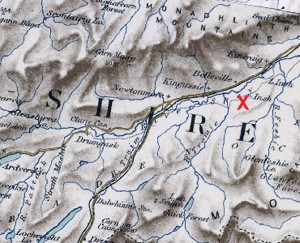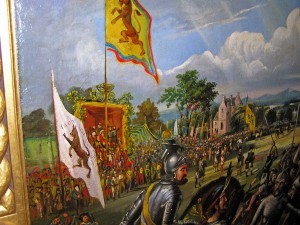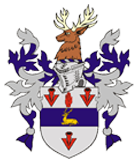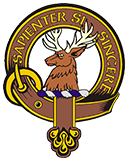History of Clan Davidson
Against this statement it has been urged that the Roman Kirk had no parson at Kingussie at that time. But this fact need not militate against the existence of Muirich at that place. The Culdee church was still strong in the twelfth century, and, as its clergy were allowed to marry, there was nothing to hinder Muirich from being the father of two sons, the elder of whom might carry on his name, and originate Clan MacPherson, while the younger, David, became ancestor of the Davidsons. Still another account is given in the Kinrara manuscript upon which Mr. A. M. Mackintosh, the historian of Clan Mackintosh, chiefly relies: This manuscript names David Dubh as ancestor of the clan, but makes him of the fourteenth century, and declares him to be of the race of the Comyns. His mother, it says, was Slane, daughter of Angus, sixth chief of the MacKintoshes, and his residence was at Nuid in Badenoch. Upon the whole, it seems most reasonable to accept the earliest account, that contained in the manuscript of 1467, which no doubt embodied the traditions considered most authentic in its time.
The chiefs of the Davidsons are said to have been settled, in early times at Invernahavon, a small estate in Badenoch, at the junction of the Truim with the Spey, and when they emerge into history in 1370 or 1386 the holders of the name appear to have been of considerable number, and in close alliance with the MacKintoshes from whose forebears they claim descent.

British General Wade’s Map on the Invernahavon area circa 1750
In the late 13th century the Camerons invaded Arkaig which was Clan Chattan land. In 1370, a dispute broke out between the Camerons and Clan Chattan including Clans MacKintoshes, MacPhersons and Davidsons. This became known as the Battle of Invernahavon. The outcome of this battle was a bitter feud between Clan Chattan and the Camerons that would last until 1666. It was alleged that during this battle the Davidson Chief and six of his seven sons were killed. Beyond this point, there is virtually no documented historical mention of the existence of Clan Davidson, as an organized Clan, until the 20th Century!
The feud which started with the Battle of Invernahavon continued for some time and is reported to be the reason for the next famous encounter at Perth. This battle became known as the Clan Battle of 1396 which took place on the North Inch of Perth in 1396.
MacIan, in his Costumes of the Clans of Scotland (circa 1845), is evidently seeking a pretext when he asserts that it was mortification at defeat on the North Inch which drove the Davidsons into obscurity, and finally induced the chief with some of his followers to remove further north, and settle in the county of Cromarty. It seems more likely that the decimation of their ranks at Invernahavon, and the losses caused by subsequent feuds, so reduced the numbers of the clan as to render it of small account during the succeeding century. See The Battles of Invernahavon and the North Inch of Perth – Late 1300s on this website for much more information about this era of Clan Davidson history.

Painting of The Battle of the North Inch – 1396. On display at the battlefield’s museum.
Lachlan Shaw in his manuscript history of Moray states that early in the 17th century the Invernahavon family changed its name from Davidson to MacPherson, the individual who did so being James of Invernahavon, commonly called Seumas Lagach, great-grandfather of John of Invernahavon. But Mr. A. M. Mackintosh, the historian of Clan Chattan, has ascertained that the James of Invernahavon referred to was son of a John MacPherson, who, according to Sir Aeneas MacPherson’s manuscript, had feued the property. It can thus be seen how Lachlan Shaw made the mistake of supposing that the Davidsons of Invernahavon had changed their name.

